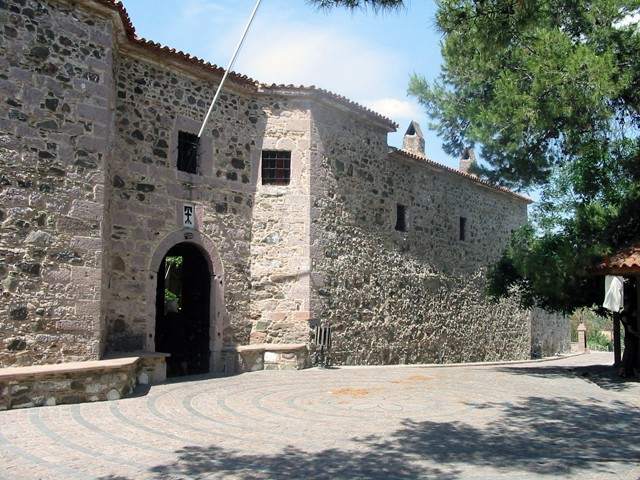The Taxiarhis Monastery |
|

“During the 9th and 10th Centuries, the Saracen pirates had become the terror of the entire island. One of their targets had been an old monastery in the Mantamados area. During one of their raids, the Saracens slaughtered all of the monastery’s monks. In his attempt to escape the inevitable, one of the monks climbed up on the monastery’s roof, but the pirates were in hot pursuit.
As they approached him with swords drawn, the Taxiarhis suddenly appeared in front of the Saracens with his own sword drawn, forcing them to retreat in a panic, and saving the life of the monk. In a show of respect and gratitude, the monk decided to create an icon in honor of the saint out of clay and his fallen comrades’ blood. However, since he did not have enough clay, the head of the saint turned out to be disproportionately large to the rest of the body.”

This is the legend of the celebrated saint’s icon at the Taxiarhis Monastery in Mantamados, the only carved icon on Lesvos. To this day, pilgrims have mixed emotions regarding this icon, since according to personal accounts the saint’s expression can at times appear severe, sad or happy, according to the message that he wants to convey to the faithful.
The monastery, which dates back to 1700, is located only a short distance from the village in a clearing surrounded by olive groves and pine forest. Taxiarhis is the patron saint not only of the area, but the entire island, and is oftentimes revered even by the Muslim Turks thanks to his many miracles. Pilgrims come to pray at the monastery’s church from throughout Greece and abroad, and leave various offerings in his honor, that include everything from swords to shoes.

The Monastery is also home to the ceremonial robe of Ecumenical Patriarch Gregory V of Constantinople that was slaughtered by the Turks, where it is revered as a holy relic of national and religious significance. The robe was purchased at an auction by Metropolitan Porfyrios Fotiades from Mantamados, who during the reign of Patriarch Gregory V was a top ranking official in the Patriarchate. After his death, his relatives donated the robe to the holy pilgrimage site. Aside from the patriarchal robe, several other religious relics, antique bibles and other artifacts are preserved at the monastery. Furthermore, numerous of the monastery’s icons date back to the 16th Century, while the natural spring that flows in the courtyard is considered on the oldest on Lesvos. Metropolitan Porfyrios’ tomb is also located on the monastery’s grounds.
The Taxiarhis Monastery
The Taxiarhis celebration is held 15 days after Easter on Myrrh Sunday, which happens to be the day that the consecration of the church of the same name took place in 1888. This is quite possibly the biggest religious celebration on the island, with thousands of visitors flocking to Lesvos from throughout Greece and abroad.
This is the celebration of the patron and protector of Mandamados and the entire island, from a wide variety of invaders and of course the brutal Turkish yoke. Prior to the Asia Minor Catastrophe in 1922, owing to the blood ties that connected many islanders with their relatives on the Anatolian coast, thousands of pilgrims would attend the celebration. The residents of Aivali and Moshonisi would reach the shores of Lesvos with their boats, and from there they were picked up by the “kirasides” with their festively decorated horses and mules, who for a nominal fee known as “kiras” would drive them up to the village.
The celebrations would last for an entire week, with live music in the coffee shops, the churches full of local worshippers and pilgrims, and the merchants setting up their stands all over the city streets. Things are quite different today. The town’s streets and public spaces have been organized and beautified, making it more accessible and pleasant to all those attending the celebrations. The celebrations now last 3 days, and the music in the coffee shops has been limited, but the number of pious pilgrims that attend the church’s services is as large as it was decades ago. A common practice for many of the island’s residents is to make the journey to the Taxiarhis Church on foot, in order to pray before his Holy Icon.
The tradition of “Sacrificing the Bull” that survives to this day has its roots in ancient and early Christian times. In honor of the saint, a bull is sacrificed on the eve of his holiday after being blessed by the priest and the ceremony takes place under the old plane tree in the church courtyard. The pilgrims dab cotton swabs in the bull’s blood and mark a cross on their foreheads. Then the sacrificed bull’s meat is cut up and used in the preparation of the traditional “kiskets”, a dish that consists of meat and cream of wheat that’s boiled all night long in giant vats, until it becomes a stew. The next day the stew is distributed to the faithful after mass.
The Taxiarhis is also celebrated on November 8th, which is an official holiday on the island.